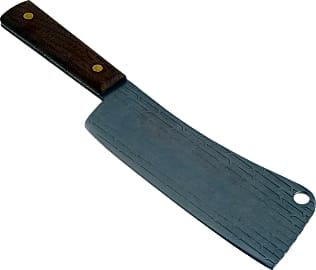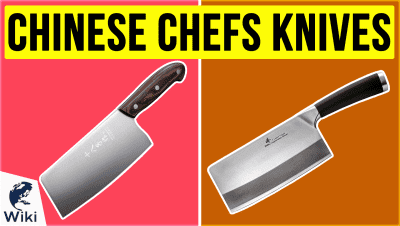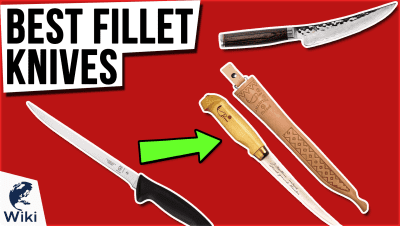The 6 Best Cleavers

This wiki has been updated 37 times since it was first published in October of 2015. Unlike Chinese cleavers meant for deft stir-fry prep, meat cleavers are heavy, resilient, and made with relatively soft metal that won't chip when processing cartilage and bones. We've included some premium options meant for full-time use, as well as more affordable choices for those who only need to break down large cuts occasionally, and either grade should hold up for years with proper care. When users buy our independently chosen editorial recommendations, we may earn commissions to help fund the Wiki.
Editor's Notes
April 08, 2021:
We very, very strongly advise against buying any of the thousands of knock-off, no-name knives available on most e-commerce website. The huge majority of these are poor-quality, re-branded throwaway blades that can't get very sharp, aren't very durable, are often inconsistent, and sometimes can barely even cut. To that end, we've gathered the most reliable brands together. Furthermore, we normally like to offer a long list of specialized knives, such as in the case of chef's knives - but we haven't exactly done that here. The difference with meat cleavers is that they are pretty simple, overall; they need weight, a soft alloy, a durable handle, flat geometry, a roughly 7- or 8-inch blade, and that's about all - there's not much more they need to address.
As far as our most recent update goes, we purged any and all no-name or poorly regarded brands, and we also removed a couple Chinese cleavers remaining. Chinese cleavers basically exist on the opposite end of the spectrum from these Western-style cleavers, and are meant for delicate vegetable prep instead of powering through resilient bones.
For heavy-duty meat chopping, the Wusthof Gourmet is almost certainly the best, but it's also expensive. The Dexter-Russell S5288 doesn't force many trade-offs yet costs half as much, and the Winco KC-301 is as cheap as they come, but will force you to make some compromises in terms of edge retention and comfort. Finally, we particularly like the Ontario Knife Company Old Hickory 76, which is a good choice for those making an early foray into carbon steel knives.
January 31, 2020:
Removed the Godmorn 7-inch and the A Cut Above Cutlery because of availability concerns. Removed the Winco Heavy Duty because of quality concerns. Replaced them with the Kamikoto Chuka Bocho, the Messermeister Meridian Elite, and the Imarku Chopper.
We demoted the Dalstrong Shogun Series X because it is actually a Chinese-style cleaver, which is not useful as a Western-style cleaver (cutting bone). It is shaped like a cleaver but the profile is much thinner so that it can be used in the same way that a chef's knife is used (this is also why it shouldn't be used to cut bone). The Wusthof Classic is an all-around great knife and has everything you look for in a cleaver - a thick profile, hardened and tempered high-carbon steel, a full-tang, and a triple pinned handle. If you're looking for brute force at an affordable price, the Dexter-Russell S5288 is quite heavy, which is useful for butchers who break down carcasses every day.
Knives are very dangerous. Please use caution when using them to avoid personal injury.
Leave It To Cleaver
In addition to cutting through bone, the tool can also be used to chop and prepare vegetables.
One of the exciting things about working in a kitchen is the versatility and specialization of both the tools and appliances available to you when preparing your meals. This is true, regardless of whether you're a professional chef cooking for your customers or a homemaker looking to prepare dinners for your family. When you need a tool with a lot of torque and dedicated edges to chop tough ingredients, a cleaver can be a valuable asset.
Commonly used by butchers and Chinese chefs, the cleaver is a type of heavy-bladed, broad knife designed to cut through heavy materials, such as thick meats, dense cartilage, coconut, and bone. Unlike other conventional kitchen knives, the cleaver is characterized by a hard edge that withstands repeated blows to the same cutting surface, making it a truly resilient tool because of its soft steel construction and thick blade.
One might think soft steel would be easier to damage, but its thickness absorbs impacts more easily than that of thin, hardened steel, which is more likely to fracture under stress. Because of its durable nature, the cleaver is one of few cutting tools that can actually be swung like a hammer with a greater dependence on the use of blunt force instead of the sharpness of its blade to hack through bone or other materials.
The cleaver resembles a hatchet with a squared blade connected to a shaped and textured handle often made from wood for superior hand comfort. In addition to cutting through bone, the tool can also be used to chop and prepare vegetables. Due to its thickness, the surface of a cleaver's blade can also be used to crush nuts or garlic.
Two main types of cleaver include the butcher and Chinese varieties. The all-purpose butcher's cleaver is typically wide-bladed with a thick spine built to cut through meat or poultry bones using its weight and momentum as leverage during repetitive chopping motions. The Chinese cleaver also features a wide-bladed design with a rectangular shape, but with a narrower spine than that of the butcher variety, making it useful for removing meat from bones or scooping previously-chopped ingredients into additional cookware (e.g. pots and pans). The Santoku knife is the Japanese equivalent to both the Chinese and butcher cleavers, ideal for slicing meat into thin cuts.
Thanks to the curvature of its blade, the Santoku promotes a natural rocking motion when used to slice through vegetables and fruit. Some Santoku knives also have Granton edges, which are characterized by hollowed-out grooves running along the length of both sides of a knife blade. These grooves create small air pockets between the items being cut and the blade for improved accuracy and ease when slicing, making the Santoku perfect for producing thin slivers of poultry, roasts, and other meats.
Chopping With Choice
When working with a kitchen tool that is naturally bulky with wide-edged blades, one's comfort is the first thing to keep in mind. Finding the best cleaver means ensuring its handle is ergonomically-designed to support the wrist and allow for powerful cutting action, but without excess weight.
For that reason, durability of both the handle and blade matter.
Many cleavers have perforated grips, which easily prevent slipping and possible injury, while also minimizing user fatigue from extended use. Unlike some other types of knives, the carbon steel blades that power the cleaver don't have to be nearly as sharp, since you'll be using blunt force with the tool in your kitchen. For that reason, durability of both the handle and blade matter.
A cleaver is not for the faint of heart, meaning that it won't necessarily operate like a regular chef's knife with less force to make precision cuts. The tool is meant for heavy-duty applications, so paying a bit extra for a sturdy handle and a rustproof blade can make all the difference, particularly in a professional setting when cooking a regular menu for large groups of people. However, safety must also be an important consideration with any cutting tool in your cutlery arsenal.
One's cleaver should also have a built-in hole for easy wall or rack hanging, as something of this size and width could take up quite a bit of room in a cutlery drawer.
A Brief History Of The Cleaver
The knife dates as far back as prehistoric times and the rise of the modern human civilization with the use of manually-sharpened stones. Oldowan stone tools represented the first rudimentary, yet vital tools for the evolution of the human race due to their simple construction and ability to be applied as a means for survival, combat, construction and food preparation. These sharpened stone tools continued to evolve over time to a point at which they would resemble their modern counterparts.
This gave birth to the eventual popularization of blunt-tipped knives that would grace most standard European dining tables by the nineteenth century.
Double-bladed knives were some of the most popular tools used before fire was harnessed to melt metal for shaping. Wooden or stone handles were often decorated with animal skins and feathers, displaying a sense of pride and tradition for those who used them. This practice continued well into the Bronze Age.
With the eventual birth of metallurgy, it was now possible to forge knives out of softer metals. Throughout the later centuries, iron and steel became commonplace for the creation of knives, making them more durable and easier to maintain. The evolution of design and forging blossomed into the use of swords, spears and axes during the times of medieval Europe.
By the early fifteenth century, the wealthy began to carry personal knives for both protection and eating purposes, many characterized by a slim, double-bladed profile meant for cutting and piercing foods.
The indistinguishable design for the modern table knife, from which many other knives have evolved (including the cleaver), can be attributed to French Cardinal Richelieu in the late 1630s. Richelieu hated the idea of having to use sharp blades to scoop food or clean teeth after a meal. He eventually convinced King Louis XIV of France to ban the use of double-bladed knives from the entire country in order to reduce violence.
This gave birth to the eventual popularization of blunt-tipped knives that would grace most standard European dining tables by the nineteenth century. Today's table knives and other utensils were standardized by the early twentieth century with the invention of stainless steel, giving rise to bread and carving knives as well as the butcher's cleaver.











